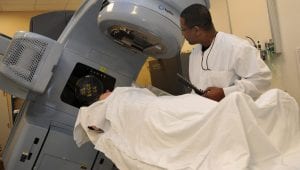High Dose Radiotherapy Improves Mesothelioma Survival in New Study
 Treating malignant pleural mesothelioma patients with high doses of targeted radiotherapy after surgery or biopsy may significantly extend their lives.
Treating malignant pleural mesothelioma patients with high doses of targeted radiotherapy after surgery or biopsy may significantly extend their lives.
That’s the message from a multi-center mesothelioma study conducted in Italy and recently published in a French medical journal.
Mesothelioma Treatment with Radiotherapy
Scientists analyzed the cases of 36 malignant pleural mesothelioma patients diagnosed between 2009 and 2012.
Nineteen of the patients were treated with a surgical procedure called pleurectomy/decortication (P/D) to removed their diseased pleural lining, part of their diaphragm, and other tissues that could host new pleural mesothelioma tumors.
The remaining 17 mesothelioma patients only had biopsies of their tumors. All of the patients underwent five days of hypofractionated (high dose) radiotherapy to one side of their chest. Patients received 25 Gy of radiation, divided into five equal doses, and delivered using a targeting technology called intensity-modulated radiotherapy (IMRT).
The procedure was not without side effects. After 37 months of follow-up, the researchers made the following observations:
- Three patients developed lung swelling (pneumonitis)
- Five patients develop moderate shortness of breath
- Six patients experienced moderate coughing
Improved Mesothelioma Survival Observed
But the best news was that, although the average survival for most pleural mesothelioma patients is a year or less, the median overall survival for the radiotherapy-treated patients was much better.
Patients who had the P/D mesothelioma surgery followed by high-dose radiotherapy had a median overall survival of 21.6 months. Those who had only biopsy followed by radiotherapy had a median overall survival of 19.4 months.
“Treatment of intact lung with pleural intensity-modulated arc irradiation in malignant pleural mesothelioma patients…proved safe and feasible, with an acceptable rate of pneumonitis,” writes lead researcher Elisabetta Parisi with IRST, a cancer research institute in Meldola, Italy. “Survival rates were encouraging for both biopsy-only and pleurectomy/decortication groups.”
The researchers are now conducting a Phase II dose-escalation trial including current mesothelioma patients so that they can observe and measure toxicity and disease-free survival, as well as overall survival.
The Challenge of Radiotherapy for Pleural Mesothelioma
Pleural mesothelioma grows on the membrane that surrounds the lungs and lies in close contact with other vital organs. Irradiating the mesothelioma tumor while protecting both the lungs and other nearby organs is especially challenging and relies on detailed planning beforehand.
There is still no accepted standard for treating pleural mesothelioma with radiotherapy. However, several recent studies have suggested that, if radiation is going to be used, IMRT may be the safest way to deliver it.
A Turkish study released in May found that IMRT delivered “efficient tumorcidal radiation dose within the safe dose limits”. Other studies conducted in Texas and New York found that mesothelioma patients who had IMRT after either EPP or P/D surgery lived longer than most people with the asbestos cancer.
Sources:
Parisi, E, et al, “High dose irradiation after pleurectomy/decortication or biopsy for pleural mesothelioma treatment”, November 10, 2017, Cancer Radiotherapy, Epub ahead of print, http://www.sciencedirect.com/science/article/pii/S1278321817303827
Ulger, S, et al, “Intensity-Modulated Radiation Therapy Improves the Target Coverage Over 3-D Planning While Meeting Lung Tolerance Doses for All Patients With Malignant Pleural Mesothelioma”, June 2017, Technology in Cancer Research & Treatment, pp. 332-338





